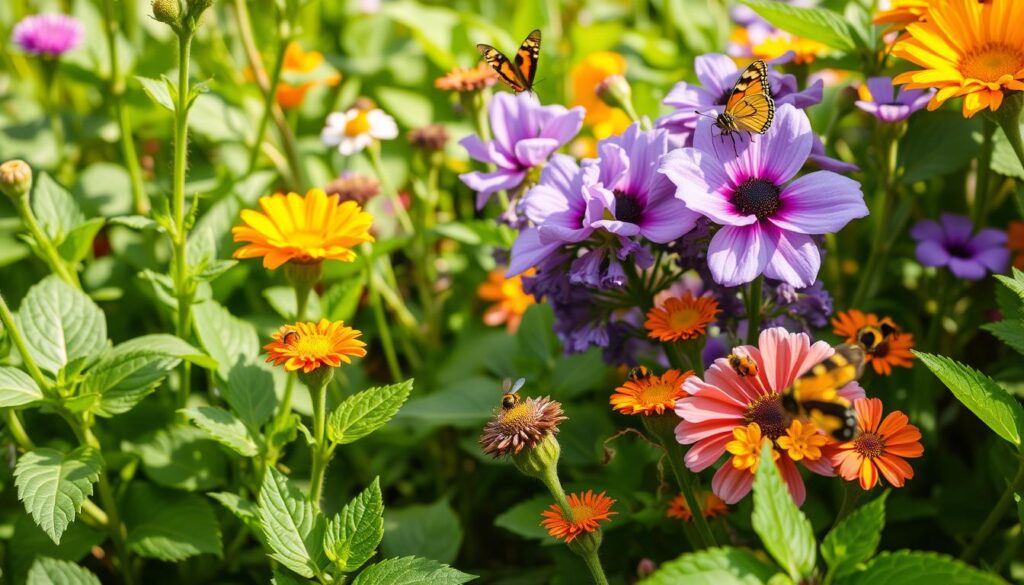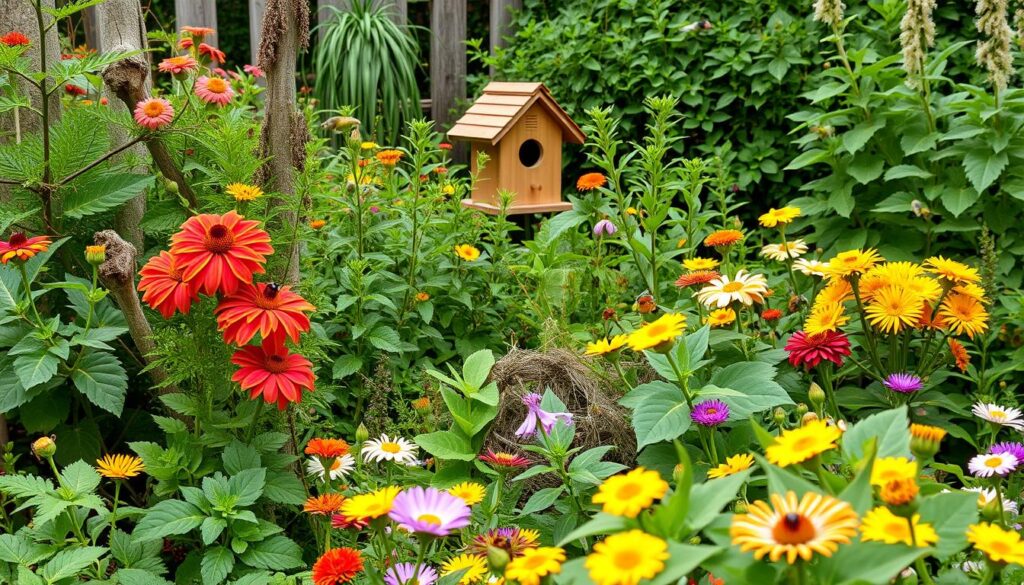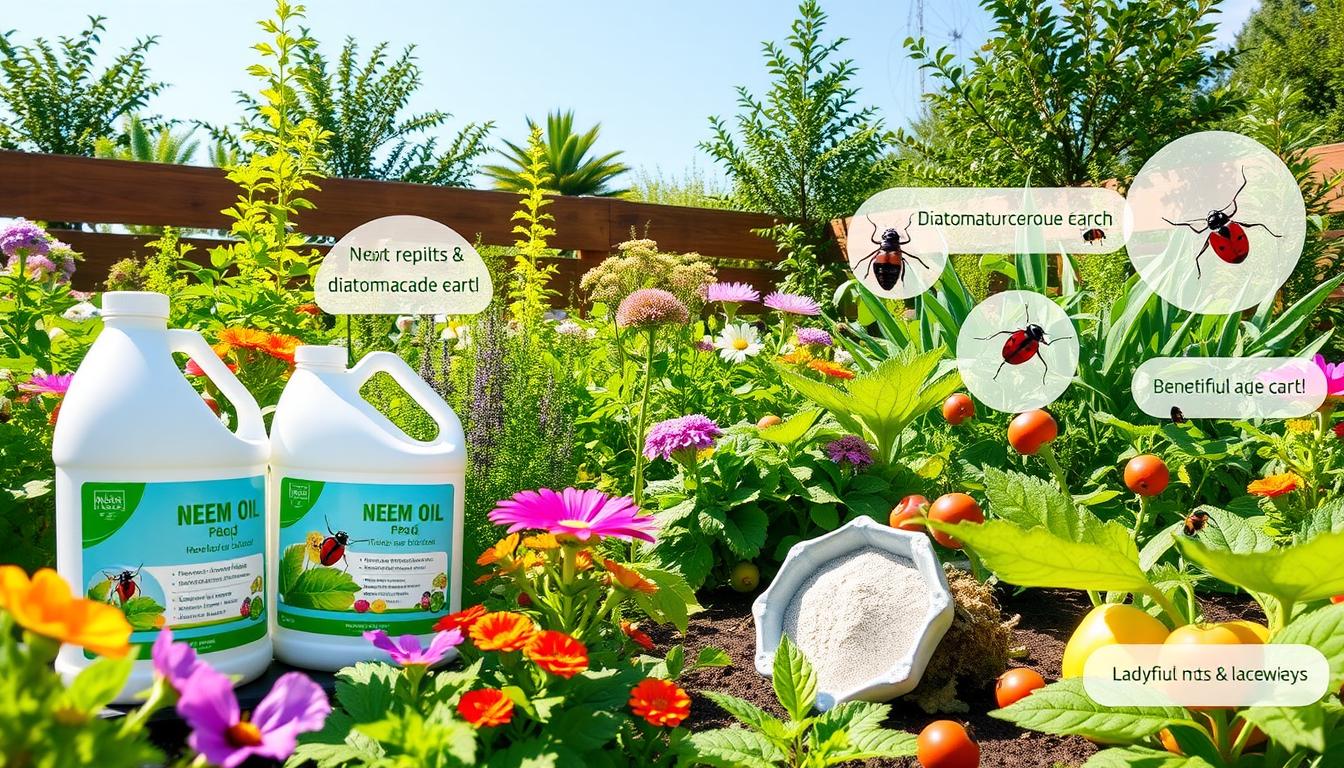This post contains affiliate links.
Imagine you’re taking care of your garden, lovingly tending to each plant. But then, pests start eating your hard work. You might want to use strong chemicals to get rid of them. But think about the harm it could cause.
We’re learning that our choices affect not just our homes but the future too. Choosing eco-friendly pest control is crucial. This guide will show you how to protect your garden and home safely.
We’ll look at ways to control pests without harming the environment or ourselves. It’s time to find methods that work well and are good for our planet.
Key Takeaways
- Eco-friendly pest control methods prioritize the health of the ecosystem while managing pest populations.
- Sustainable pest management approaches reduce harm to beneficial insects and the environment.
- Utilizing natural repellents like peppermint oil can keep pests at bay without toxic chemicals.
- Integrated Pest Management (IPM) combines various techniques for effective pest control, minimizing environmental impact.
- Natural pesticides, such as pyrethrum sprays and microbial insecticides, offer safer alternatives to traditional chemicals.
Understanding Eco-Friendly Pest Control
Eco-friendly pest control uses methods that keep homes and the environment safe. Places like Texas, Oklahoma, Mississippi, and Louisiana are using these methods more. Homeowners want to avoid toxic chemicals for their families’ health.
This approach focuses on using fewer harmful substances. It also aims to prevent diseases from pests. Natural products are preferred for their safety and environmental benefits.
Using natural products can prevent serious health problems. These include skin issues and long-term health risks like cancer. This makes homes safer for families and pets.
Integrated Pest Management (IPM) is key in eco-friendly pest control. It uses inspections, prevention, and targeted treatments. This method tackles pest problems in a complete way.
Biological control uses natural enemies to fight pests. This reduces the need for harsh chemicals. It helps keep homes safe and supports biodiversity.
There are many ways to practice eco-friendly pest control. Keeping homes clean and using natural traps are some methods. These solutions can save money in the long run by avoiding chemical costs.
Using eco-friendly pest control methods is reliable. They offer a good alternative to traditional pest control. This approach is better for the environment and health.
Choosing sustainable gardening giftsencourages eco-friendly practices. It inspires people to care for their homes and gardens in a green way.
Benefits of Sustainable Pest Management
Sustainable pest management offers many benefits over traditional methods. It focuses on solving pest problems while keeping the environment safe. This approach helps create a healthier world for everyone.
Long-Term Effectiveness
Sustainable pest management is very effective over time. It uses products and strategies that help prevent pests from becoming resistant. This means fewer problems and better control of pests.
Safety for Pets and Children
Using eco-friendly methods is safer for homes with pets and kids. Traditional pest control often uses harmful chemicals. These can cause serious health issues. Eco-conscious pest extermination uses safer, biodegradable products.
Protection of Beneficial Insects
Sustainable pest management also protects important insects. Traditional pesticides can harm bees and butterflies, which are vital for pollination. Choosing organic pest eradication helps keep these insects safe and ecosystems balanced.

Integrated Pest Management (IPM)
Integrated Pest Management (IPM) is a detailed plan for controlling pests without harming the environment. It combines different methods and focuses on stopping problems before they start. This makes it a key part of eco-friendly pest control.
IPM starts with knowing the pests and stopping them before they get in. Preventive measures like sealing holes and keeping things clean help a lot. These steps make pest control more effective over time.
It’s important to check pest control plans often to keep them green. Using natural, cultural, and physical methods helps avoid harmful chemicals. Chemicals are used only when necessary, keeping everyone and the environment safe.
| IPM Principles | Details |
|---|---|
| Identification of Pests | Accurate pest identification allows for effective management strategies. |
| Prevention | Implementing measures to prevent pest invasions before they occur. |
| Monitoring | Regular monitoring gives early detection of pest issues for timely interventions. |
| Control | Utilizes a mix of methods to effectively manage pest populations with minimal environmental damage. |
Choosing Integrated Pest Management helps protect the environment and keeps families and pets safe. It’s a smart move for long-term results and less chemical use. This approach makes our ecosystems healthier.
Biological Controls: Nature’s Solution
Biological control methods use nature to fight pests. They employ natural predators and microbial insecticides. This eco-friendly approach reduces synthetic chemical use, making ecosystems healthier and farming more sustainable.
Natural Predators for Pest Management
Introducing beneficial insects helps manage pests naturally. Some key predators include:
- Ladybugs, which eat aphids.
- Lacewings that target pest larvae.
- Parasitic wasps that lay eggs inside pests.
These natural allies not only control pests but also boost biodiversity. Their presence helps maintain ecosystem balance, making them vital for eco-friendly pest control.
Microbial Insecticides Explained
Microbial insecticides are key in biological pest control. Bacillus thuringiensis (Bt) is especially effective. It targets specific pests safely, protecting beneficial insects. Microbial biocontrol agents are also effective against soil-borne diseases, supporting sustainable farming.
| Type of Biopesticide | Examples | Target Pests | Advantages |
|---|---|---|---|
| Microbial Pesticides | Bacillus thuringiensis (Bt) | Caterpillars, beetles | Highly specific, minimal impact on non-target species |
| Plant-Incorporated Protectants (PIPs) | Genetically Modified Crops | Varied pests | Inherent pest resistance, reduced pesticide need |
| Biochemical Pesticides | Plant extracts, pheromones | General pest populations | Non-toxic action, environmentally friendly |

Natural Pest Prevention Techniques
Proactive steps can make gardening better and keep pests away naturally. By helping beneficial insects and using companion planting, you create a healthy garden. This approach supports both plant health and biodiversity, making it sustainable.
Creating an Inviting Environment for Beneficial Insects
It’s key to attract beneficial insects for pest control. They eat pests, helping manage them naturally. To welcome them:
- Plant a variety of flowers to attract pollinators.
- Grow native plants to support local insects.
- Learn what beneficial insects need for food and shelter.
Also, using natural pest prevention like ladybugs or lacewings can control pests safely.
Using Companion Planting to Deter Pests
Companion planting is a smart way to grow plants that keep pests away. For example:
| Plant | Repellent Target |
|---|---|
| Marigold | Nematodes and aphids |
| Basil | Flies and mosquitoes |
| Lavender | Moths and fleas |
Adding herbs like cinnamon, peppermint, and tea tree oil can also help. Regular checks and proper waste disposal are key to a successful garden. The aim is to prevent pests and care for your garden.
Botanical and Organic Pesticides
Many people now choose botanical and organic pesticides for non-toxic pest control. These products come from nature, offering a safer choice than regular pesticides. Neem oil and pyrethrin are especially good at fighting pests without harming the environment.
Effective Ingredients for Organic Pest Control
Neem oil comes from neem tree seeds and fights pests and fungi. It stops insects from eating and breeding. Pyrethrin, from chrysanthemum flowers, quickly kills many insects. Both are safe for most living things and keep pests away.
For more on plant-based pesticides, check out this study.
How to Use Neem Oil and Pyrethrin
Using neem oil and pyrethrin right is key. Mix neem oil with water and a bit of natural soap to make it work better. Spray it on plants in the early morning or late evening to avoid losing it to the sun.
Pyrethrin works the same way, but follow the instructions on the label. This way, you get good pest control while being kind to the planet. For more organic pest control tips, visit this resource.
Cultural Practices for Eco-Conscious Pest Extermination
Cultural practices are key to managing pests in a sustainable way. They help reduce the need for harmful chemicals and keep our ecosystems healthy. Two main methods are crop rotation and using water wisely.
Crop Rotation as a Pest Control Strategy
Crop rotation means changing what crops grow in an area each season. It makes it tough for pests to find food. By switching crops, pests struggle to adapt, helping the soil and attracting good bugs.
Proper Irrigation Techniques
Using water right is vital to stop pests. Drip irrigation is a good way to keep soil dry. It stops pests like mosquitoes from growing, making plants healthier and pest-free.
| Practice | Benefits | Impact on Pests |
|---|---|---|
| Crop Rotation | Improves soil health, disrupts pest cycles | Reduces pest establishment |
| Drip Irrigation | Water efficiency, minimizes standing water | Discourages mosquitoes and other pests |
Physical Controls: Barriers and Traps
Using physical controls is a smart way to fight pests without chemicals. Barriers and traps help homeowners manage pests safely. Screens, nets, and row covers keep pests away from plants and buildings.
This method is good for the environment and supports sustainable pest control. It’s a non-toxic way to keep pests at bay.
How to Use Screens and Barriers Effectively
Setting up screens and barriers needs a careful plan. They block insects from getting inside and protect crops from pests. They let light and moisture through, too.
It’s key to check these barriers often for any holes or damage. This keeps them working well. It’s a big help in keeping pests out of gardens and greenhouses.
Choosing the Right Traps for Your Needs
Choosing the right trap depends on the pest you’re fighting. Sticky traps catch flying bugs, while pheromone traps track specific pests. Knowing what each trap does helps manage pests better.
Using these traps is part of a bigger plan to control pests. It shows how important non-chemical methods are in fighting pests.
FAQ
What is eco-friendly pest control?
How does sustainable pest management differ from traditional methods?
What is Integrated Pest Management (IPM)?
How can biological controls help manage pests naturally?
What are some natural pest prevention techniques?
How do botanical and organic pesticides work?
What role do cultural practices play in pest control?
What are physical controls in pest management?
This post contains affiliate links.

